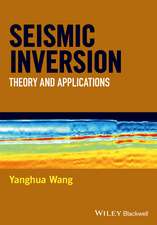Electronic Distance Measurement: An Introduction
Autor Jean M. Rüegeren Limba Engleză Paperback – 17 sep 1996
Preț: 500.59 lei
Preț vechi: 588.92 lei
-15% Nou
Puncte Express: 751
Preț estimativ în valută:
95.79€ • 100.28$ • 79.26£
95.79€ • 100.28$ • 79.26£
Carte tipărită la comandă
Livrare economică 05-19 aprilie
Preluare comenzi: 021 569.72.76
Specificații
ISBN-13: 9783540611592
ISBN-10: 3540611592
Pagini: 300
Ilustrații: XIX, 276 p.
Dimensiuni: 155 x 235 x 16 mm
Greutate: 0.45 kg
Ediția:Softcover reprint of the original 4th ed. 1996
Editura: Springer Berlin, Heidelberg
Colecția Springer
Locul publicării:Berlin, Heidelberg, Germany
ISBN-10: 3540611592
Pagini: 300
Ilustrații: XIX, 276 p.
Dimensiuni: 155 x 235 x 16 mm
Greutate: 0.45 kg
Ediția:Softcover reprint of the original 4th ed. 1996
Editura: Springer Berlin, Heidelberg
Colecția Springer
Locul publicării:Berlin, Heidelberg, Germany
Public țintă
ResearchCuprins
1 History.- 2 Physical Laws and Units Related to EDM.- 2.1 Definitions.- 2.2 Frequency Spectrum.- 2.3 Velocity of Light in a Vacuum.- 2.4 Units and Their Definitions.- 3 Principles and Applications of EDM.- 3.1 Pulse Method.- 3.2 Phase Difference Method.- 3.3 Doppler Methods.- 3.4 Interferometry.- 4 Basic Working Principles of Electronic Distance Meters.- 4.1 Electro-Optical Instruments.- 4.2 Microwave Instruments.- 5 Propagation of Electromagnetic Waves Through the Atmosphere.- 5.1 Atmospheric Transmittance.- 5.2 Range of EDM Instruments.- 5.3 Phase Refractive Index.- 5.4 Group Refractive Index of Light and NIR Waves for Standard Conditions.- 5.5 Group Refractive Index of Light and NIR Waves at Ambient Conditions.- 5.6 Refractive Index of Microwaves.- 5.7 Coefficient of Refraction.- 5.8 Measurement of Atmospheric Parameters.- 5.9 Determination of the Refractive Index.- 6 Velocity Corrections to Measured Distances.- 6.1 Reference Refractive Index.- 6.2 First Velocity Correction.- 6.3 Real-Time Application of First Velocity Correction by EDM Instrument.- 6.4 Second Velocity Correction.- 6.5 Refined Method of Reduction of Measured Distance to Wave Path Chord.- 7 Geometrical Corrections.- 7.1 Reduction to the Spheroid Using Station Heights.- 7.2 Reduction to the Spheroid, Using Measured Zenith Angles.- 8 Miscellaneous Corrections, Computations and Numerical Examples.- 8.1 Correction of Measured Distance to Zenith Angle Ray Path.- 8.2 Eye-to-Object Corrections for Zenith Angles and Distances.- 8.3 Height Difference from Measured Zenith Angle(s) and Slope Distance.- 8.4 Determination of the Coefficient of Refraction from Reciprocal Zenith Angle Measurements.- 8.5 Reduction to Centre of Distances.- 8.6 Numerical Examples.- 9 Electro-Optical Distance Meters.- 9.1 Classification of Electro-Optical Distance Meters.- 9.2 Design of Some Electro-Optical Distance Meters.- 10 Reflectors.- 10.1 Introduction.- 10.2 Glass Prism Reflectors.- 11 Batteries and Other Power Sources.- 11.1 Review of Power Sources.- 11.2 Batteries Used in EDM.- 11.3 Sealed Nickel-Cadmium Batteries.- 12 Errors of Electro-Optical Distance Meters.- 12.1 Additive Constant.- 12.2 Short Periodic Errors.- 12.3 Scale Errors.- 12.4 Non-Linear Distance-Dependent Errors.- 12.5 Summary and Mathematical Model of Errors.- 13 Calibration of Electro-Optical Distance Meters.- 13.1 Introduction.- 13.2 Calibration on EDM Baselines.- 13.3 Calibration on Cyclic Error Testlines.- 13.4 Calibration of Modulation Frequency.- 13.5 Accuracy Specifications of EDM Instruments.- Appendices.- A. First Velocity Correction for Precise Electro-Optical Distance Measurement.- B. Tables of Saturation Water Vapour Pressures.- C. Parameters of the ICAO Standard Atmosphere.- D. Data of a Selection of Electro-Optical Distance Meters as Required for the Derivation of the First Velocity Correction and for Calibration Purposes.- E. Technical Data of a Selection of Short Range Distance Meters.- F. Technical Data of a Selection of Pulse Distance Meters.- G. Technical Data of a Selection of Long Range Distance Meters.- H. Critical Dimensions of a Selection of Reflectors.- References.
Textul de pe ultima copertă
Electronic Distance Measurement
This text gives an up-to-date introduction into electronic distance measurement (EDM) with a comprehensive review of modern equipment and procedures. It is excellently suited as a text for undergraduate and graduate students and an invaluable reference for practicing surveyors, geodesists and other scientists using EDM as a measuring tool. This fourth edition of a text first published in Sydney in 1978 is based on Rüeger's teaching experience at the University of New South Wales in Sydney, Australia.
Introductory chapters provide an overview of relevant laws of physics and basic principles of different types of EDM instruments. The following chapters examine velocity corrections, derive geometrical reductions from first principles and explain the design of state-of-the-art electro-optical distance meters. The final chapters introduce reflectors, power sources and instrument errors, and conclude with measurement and analysis procedures for the calibration of distance meters.
This text gives an up-to-date introduction into electronic distance measurement (EDM) with a comprehensive review of modern equipment and procedures. It is excellently suited as a text for undergraduate and graduate students and an invaluable reference for practicing surveyors, geodesists and other scientists using EDM as a measuring tool. This fourth edition of a text first published in Sydney in 1978 is based on Rüeger's teaching experience at the University of New South Wales in Sydney, Australia.
Introductory chapters provide an overview of relevant laws of physics and basic principles of different types of EDM instruments. The following chapters examine velocity corrections, derive geometrical reductions from first principles and explain the design of state-of-the-art electro-optical distance meters. The final chapters introduce reflectors, power sources and instrument errors, and conclude with measurement and analysis procedures for the calibration of distance meters.














